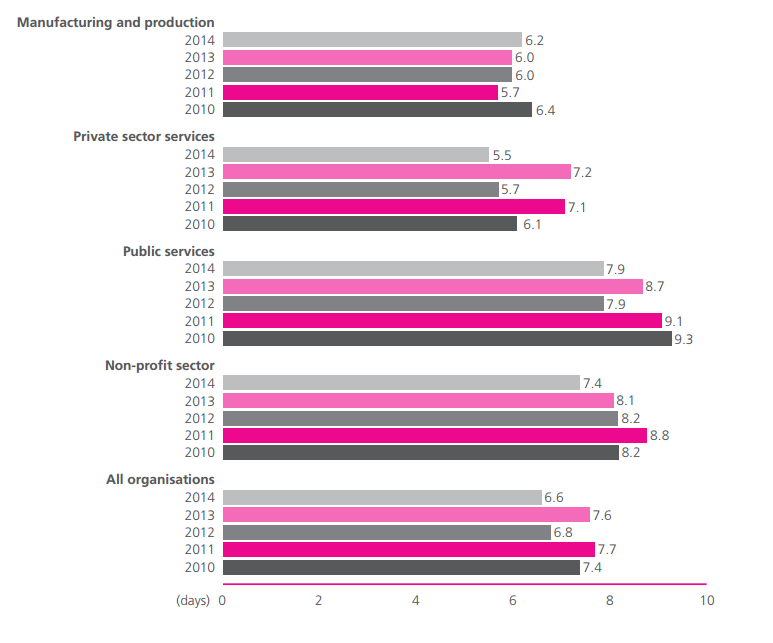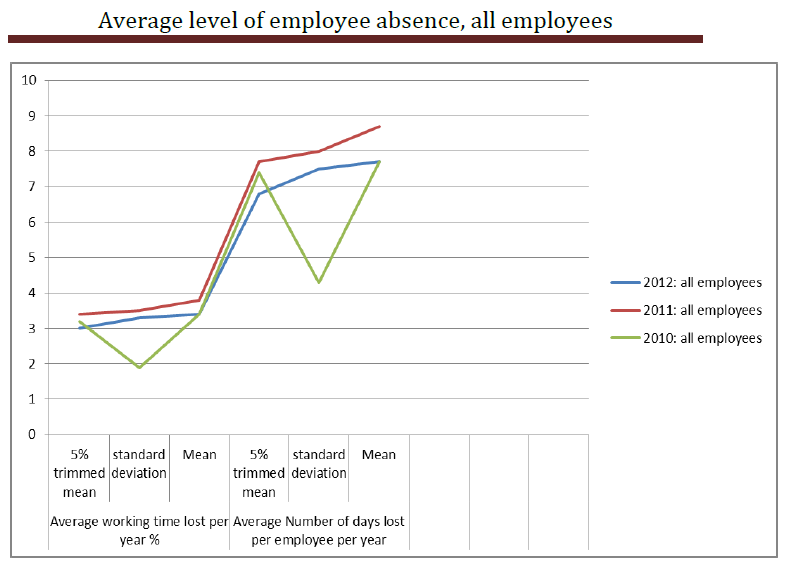Employee Absence

The information in the graph above indicates quite explicitly that the current absence rates among employees in public and private organizations leave much to be desired. Based on the information provided in the chart above (the left bar indicating the number of days lost), the Public Services department has been suffering from the employee absence factor to the greatest extent (8.58% average). Similarly, the non-profit sector showed a rather high employee absence rates (81.4%) (Chartered Institute of Personnel and Development 10). The identified characteristics of the sectors in question show that there is a strong need to reconsider the employee benefit package elements provided to the people employed in the given realms. It is also quite peculiar that the variable rates are the highest in the private sector area. It could be hypothesized that the observed phenomenon owns its existence to the lack of homogeneity in the leadership approaches adopted by the leaders of private entrepreneurship. Indeed, in contrast to public and non-profit companies, the leadership approaches in which can be deemed as rather stiff (Chartered Institute of Personnel and Development, 2014), private corporations are comparatively free in the choice of the HR management strategies, as well as the leadership strategies used to reinforce the significance of the company standards and, therefore, improve the employees’ performance rates.
It is also quite remarkable that the manufacturing sector has been showing comparatively consistent and admittedly high rates of employee attendance. The identified tendency shows that a more profound analysis of the specified environment could be a means of addressing the current drop in the staff workplace attendance rates. A detailed overview of the strategies that the manufacturing entrepreneurship managers adopt to increase the specified factor may serve as the foundation for improving the present-day attendance rates.

As the graph provided above shows quite clearly, the absence levels have been quite inconsistent over the past three years. The levels of absenteeism have been increasing for the most part, which shows that the present-day motivation strategy could use significant improvements. Indeed, the fact that the staff members prefer to ditch their workplace responsibilities points to the need to reconsider the current leadership approach and the model for the organizational behavior that it suggests.
In addition, the fact that the standard deviation rates have been changing over the identified time period deserves to be brought up. On the one hand, the specified characteristics of the data show that the tendency for absenteeism has not been common with all staff members, some of them following the expected organizational behavior standards. On the other hand, the striking difference between the standard deviation demonstrated by the participants in 2012, 2013, and 2014 points quite graphically to the lack of consistency in the employees’ motivation.
The increase in the average absence rates demonstrated in the report, in its turn, indicates that the lack of awareness about the importance of staff satisfaction and employee motivation is becoming a significant threat to the overall performance of companies worldwide. Indeed, absence from the workplace can be attributed to a variety of factors, the unwillingness to excel in one’s performance being the key one. Apart from the leadership issue, the identified phenomenon can be viewed as the direct impact of the changes to the benefits package provided to the staff. Specifically, the options for sick leave, as well as parental leave, insurance concerns, etc., are likely to be the triggers for the specified phenomenon to occur.
Reference
Chartered Institute of Personnel and Development. Annual Survey Report 2014. 2014. Web.